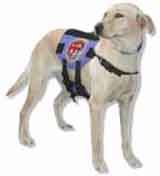Dog Behavior Problems and TrainingOver-Excitability And Inhibition Behavior In Dogs |
|
|
Over excitability is the term used to describe most of the problem dogs we see, especially when they are stressed by new surroundings, strangers, other dogs, social isolation, physical restraint, stimulation, and sudden loud noises. At the other end of the spectrum of behavioral reactivity, we see highly inhibited animals that react to stress by total inaction or slow, stiff movements, and apparent depression, seeming to lose contact with environmental stimuli. The problem usually occurs while the owners sleep at night, or when the dogs are left alone, especially for a long period of time. The stress of being ignored, even if the owners are there, stimulates the mother to introverted behavior (self-mutilation) and stimulates the extremely excitable son toward extroverted over-activity. Both excitability and inhibition can be heightened by many herbs and synthetic drugs, as well as those extracted from living tissues. The fact that such drugs do not affect all individuals (dogs or people) in the same way supports the belief that the balance among internal neurochemicals may be the primary factor influencing the behavioral expression of excitability or inhibition. The individual body chemistry of animals develops and fluctuates throughout life. Hormonal imbalances produce not only structural and physiologic, but behavioral changes as well. Among the body's hormone-producing glands and controlling organs, the emotional centers of the brain's limbic system appear to exert considerable influence. Certain drugs not only influence the balance among these factors, but mild or extreme psychological stress can produce subtle and gross neurochemical imbalances. The fact that seemingly mildly stressful experiences induce these reactions may help explain a good deal of what is generally described as "spontaneous aggression" or the popularly labeled "Springer rage syndrome". In this case, the nervous processes responsible for defensive behavior, such as a dog's biting, can be sensitized but not fully activated by mildly threatening stimuli. However, depending on the particular dog's nervous system makeup, repeated stimulation can push the dog over the brink and into a full-blown "rage avalanche," where up to several minutes of furious behavior are necessary to exhaust the imbalance and restore equilibrium. The dog then often resumes its usual gregarious personality or appear contrite, confused. Most dogs that are highly excitable usually exhibit a behavior problem for which the owners have applied various degrees and types of punishment. These included scolding (a stimulus that can facilitate a snapping response), muzzle-clamping with the hands, shaking by the scruff or jowls, physical take-downs, and mild to severe hitting with the hands or objects such as rolled up newspapers.Back to the Dog Behavior Problems and Training page
| |
|
Related News About Dogs ' ); // get rid of newsfeed display by carp CarpConf('poweredby',''); CarpCacheShow('http://dogguidance.com/dogblog/?feed=rss2'); ?>
|
|
|
|
|
|
Copyright © 2006-2007 dogguidance.com |


